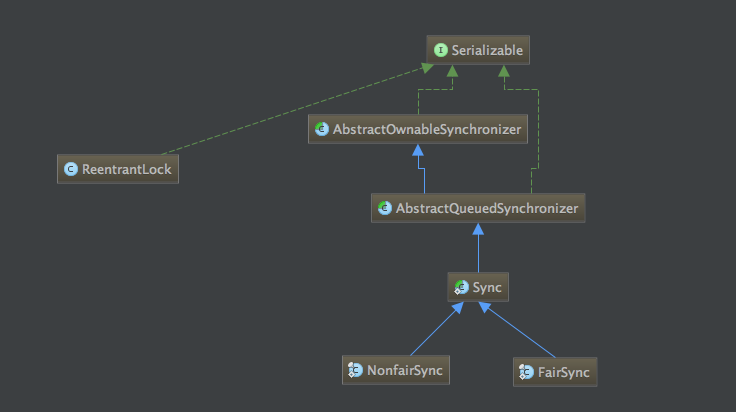昨天继续翻了下ReentrantLock的代码,这里做下记录。
总体思路是AQS的思想,关于什么是AQS就不阐述了,自己搜索喽,阅读代码那关键就是实现了。

ReentrantLock的操作,lock、release这些操作实际上都是通过通过一个Sync的实例来实现的。
Sync的类结构见上图。
上代码:
/** * Creates an instance of {@code ReentrantLock}. * This is equivalent to using {@code ReentrantLock(false)}. */ public ReentrantLock() { sync = new NonfairSync(); }
默认创建的是NonfairSync实例。
/** * Acquires the lock. * * <p>Acquires the lock if it is not held by another thread and returns * immediately, setting the lock hold count to one. * * <p>If the current thread already holds the lock then the hold * count is incremented by one and the method returns immediately. * * <p>If the lock is held by another thread then the * current thread becomes disabled for thread scheduling * purposes and lies dormant until the lock has been acquired, * at which time the lock hold count is set to one. */ public void lock() { sync.lock(); }
lock操作,委托sync的实际对象NonfairSync或者FairSync来操作。
NonfairSync代码:
/** * Sync object for non-fair locks */ static final class NonfairSync extends Sync { private static final long serialVersionUID = 7316153563782823691L; /** * Performs lock. Try immediate barge, backing up to normal * acquire on failure. */ final void lock() { if (compareAndSetState(0, 1)) setExclusiveOwnerThread(Thread.currentThread()); else acquire(1); } protected final boolean tryAcquire(int acquires) { return nonfairTryAcquire(acquires); } }
Fairsync代码:
/** * Sync object for fair locks */ static final class FairSync extends Sync { private static final long serialVersionUID = -3000897897090466540L; final void lock() { acquire(1); } /** * Fair version of tryAcquire. Don't grant access unless * recursive call or no waiters or is first. */ protected final boolean tryAcquire(int acquires) { final Thread current = Thread.currentThread(); int c = getState(); if (c == 0) { if (!hasQueuedPredecessors() && compareAndSetState(0, acquires)) { setExclusiveOwnerThread(current); return true; } } else if (current == getExclusiveOwnerThread()) { int nextc = c + acquires; if (nextc < 0) throw new Error("Maximum lock count exceeded"); setState(nextc); return true; } return false; } }
lock()操作委托给Sync操作实际上核心是:acquire(1);acquire的操作是模板方法模式实现,在父类AbstractQueuedSynchronizer中实现:
/** * Acquires in exclusive mode, ignoring interrupts. Implemented * by invoking at least once {@link #tryAcquire}, * returning on success. Otherwise the thread is queued, possibly * repeatedly blocking and unblocking, invoking {@link * #tryAcquire} until success. This method can be used * to implement method {@link Lock#lock}. * * @param arg the acquire argument. This value is conveyed to * {@link #tryAcquire} but is otherwise uninterpreted and * can represent anything you like. */ public final void acquire(int arg) { if (!tryAcquire(arg) && acquireQueued(addWaiter(Node.EXCLUSIVE), arg)) selfInterrupt(); }
其中的tryAcquire留给实现者来实现,这里是FairSync和NonfairSync的主要差别。